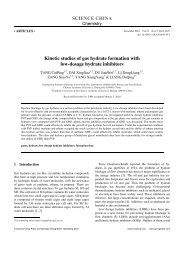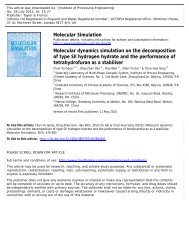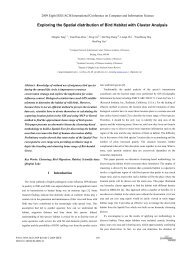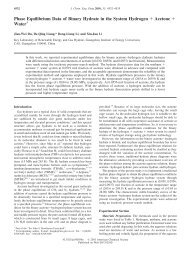BIOINFORMATICS APPLICATIONS NOTE
BIOINFORMATICS APPLICATIONS NOTE
BIOINFORMATICS APPLICATIONS NOTE
Create successful ePaper yourself
Turn your PDF publications into a flip-book with our unique Google optimized e-Paper software.
wapRNA<br />
we first remove adaptors sequences, cluster those identical reads into<br />
unique tags, map tags to assigned genome sequences and use those<br />
perfect hits for the following analysis. Then we filter those non-miRNA<br />
(including snRNA, tRNA, rRNA, mRNA, etc.) tags and annotate conserved<br />
miRNA by comparing tags to miRBase (Griffiths-Jones, 2006; Griffiths-<br />
Jones et al., 2008) database. Finally, we predicate new miRNAs using<br />
miRdeep software (Friedlander et al., 2008). While for SOLiD platform,<br />
due to the color-spaced sequences, we integrate the RNA2MAP package<br />
(http://solidsoftwaretools.com/gf/project/rna2map/) for filtering the nonmiRNA<br />
sequences, annotating the known miRNAs by aligning to the miRNA<br />
precursor sequences from miRBase, and mapping to the genome sequence for<br />
predicting novel miRNAs. The miRNA targets are predicated and combined<br />
by using RNAhybrid (Kruger and Rehmsmeier, 2006) and miRanda (Betel<br />
et al., 2010) software.<br />
Moreover, we developed an independent module for detecting<br />
differentially expressed genes (DEG), functional classification (based on GO<br />
and KEGG database), and miRNA target predication.<br />
2.2 Case study<br />
To demonstrate the functionality of wapRNA, we used it to analyze SOLiD<br />
mRNA data from SRA009022 (Cui et al., 2010) and miRNA data (Cai<br />
et al., 2010) produced in our lab. We also tested our Solexa pipeline using<br />
mRNA data from SRR037165 (Wu et al., 2010) and Solexa miRNA data<br />
from SRR026761 (Morin et al., 2008). All analyzed results were showed in<br />
demo results part, and all these jobs were run on a Red Hat Enterprise Linux<br />
Cluster with 12 16 GB-RAM compute nodes and a total of 96 CPU cores.<br />
For the SOLiD mRNA pipeline, we got 13.6% multiple mapped reads and<br />
32.8% unique mapped reads, which are relatively higher than Cui et al.’s<br />
(2010) original results. The difference is caused by parameter setting in<br />
mapping procedure. For the miRNA pipeline, we identified 397 (341 unique)<br />
known miRNA and 138 (111) novel miRNA in only one sample (hESC),<br />
while 315 known miRNA and 100 novel miRNA in hESC samples by Morin<br />
et al.’s (2008) results, about 82% of those known miRNA and 87% of those<br />
novel miRNAs are overlapped between the two methods. The other two tests<br />
also showed very similar results with original results.<br />
3 IMPLEMENTATION<br />
wapRNA consists of front- and back-end programs. The frontend<br />
program, constructed based on Java Server Page (JSP) 2.0<br />
technology, is in charge of tasks submission and results display.<br />
We used the Struts (http://struts.apache.org), Spring (http://<br />
www.springsource.org) and Hibernate (http://www.hibernate.org/)<br />
framework to enhance the flexibility and extendibility, and Mysql5.0<br />
as the DBMS to store the interim and final results. The back-end<br />
program consists of series of Perl and Shell scripts, it is mainly in<br />
charge of the data processing.<br />
The executable packages for four pipelines designed and<br />
implemented using Java program, which can be download from our<br />
web site. All the packages can be run on 64-bit Linux system. Before<br />
running the packages, some essential tools declared in the download<br />
page are needed to be pre-installed in the system.<br />
4 DISCUSSION<br />
The wapRNA web service provides users to analyze next-generation<br />
sequencing mRNA and miRNA data directly and simply by an easyto-use<br />
browser user interface. The service includes major processes<br />
for the next-generation mRNA or miRNA data analysis, including<br />
preprocessing raw sequenced reads, mapping tags to reference<br />
sequences, gene expression annotation, and other downstream<br />
functional analysis such as detecting differentially expressed genes,<br />
Gene Ontology and KEGG pathway analysis for RNA, novel<br />
miRNA predication and miRNA target prediction. Moreover, we<br />
also provide executable packages for users to build their pipeline<br />
locally. However, some steps are still improvable, for example, we<br />
ignored those multiple mapping reads which may be very important<br />
for duplicated genes or members of gene family. And also, there<br />
are a few additional features we have not involved, such as new<br />
transcript identification, alternative splicing, these features will be<br />
integrated into the wapRNA in the near future.<br />
ACKNOWLEDGEMENTS<br />
We would like to thank all the members of Genome and<br />
Bioinformatics platform in BIG for their assistance during the<br />
pipeline development, and thank Peng Cui, Xiaomin Yu for the<br />
previous work on the RNA and miRNA research, and also thank<br />
Kesheng Liu for the solid data support.<br />
Funding: Natural Science Foundation of China (30900831 to S.S.);<br />
Ministry of Science and Technology of the People’s Republic of<br />
China (BSDN2009-15 to W.Z.); Knowledge Innovation Program of<br />
the Chinese Academy of Sciences (KSCX2-EW-R-01-04 to S.H.).<br />
Conflict of Interest: none declared.<br />
REFERENCES<br />
Betel,D. et al. (2010) Comprehensive modeling of microRNA targets predicts functional<br />
non-conserved and non-canonical sites. Genome Biol., 11, R90.<br />
Bohnert,R. and Ratsch,G. (2010) rQuant.web: a tool for RNA-Seq-based transcript<br />
quantitation. Nucleic Acids Res., 38, W348–W351.<br />
Cai,Y. et al. (2010) Novel microRNAs in silkworm (Bombyx mori). Funct. Integr.<br />
Genomics, 10, 405–415.<br />
Cui,P. et al. (2010) A comparison between ribo-minus RNA-sequencing and polyAselected<br />
RNA-sequencing. Genomics, 96, 259–265.<br />
Friedlander,M.R. et al. (2008) Discovering microRNAs from deep sequencing data<br />
using miRDeep. Nat. Biotechnol., 26, 407–415.<br />
Goncalves,A. et al. (2011) A pipeline for RNA-seq data processing and quality<br />
assessment. Bioinformatics, 27, 867–869.<br />
Griffiths-Jones,S. (2006) miRBase: the microRNA sequence database. Methods Mol.<br />
Biol., 342, 129–138.<br />
Griffiths-Jones,S. et al. (2008) miRBase: tools for microRNA genomics. Nucleic Acids<br />
Res., 36, D154–D158.<br />
Hackenberg,M. et al. (2009) miRanalyzer: a microRNA detection and analysis tool for<br />
next-generation sequencing experiments. Nucleic Acids Res., 37, W68–W76.<br />
Harris,M.A. et al.; Consortium,G.O. (2004) The Gene Ontology (GO) database and<br />
informatics resource. Nucleic Acids Res., 32, D258–D261.<br />
Huang,P.J. et al. (2010) DSAP: deep-sequencing small RNA analysis pipeline. Nucleic<br />
Acids Res., 38, W385–W391.<br />
Kanehisa,M. and Goto,S. (2000) KEGG: Kyoto Encyclopedia of Genes and Genomes.<br />
Nucleic Acids Res., 28, 27–30.<br />
Kruger,J. and Rehmsmeier,M. (2006) RNAhybrid: microRNA target prediction easy,<br />
fast and flexible. Nucleic Acids Res., 34, W451–W454.<br />
Li,H. and Durbin,R. (2009) Fast and accurate short read alignment with Burrows-<br />
Wheeler transform, Bioinformatics, 25, 1754–1760.<br />
Morin R.D. et al. (2008) Application of massively parallel sequencing to microRNA<br />
profiling and discovery in human embryonic stem cells. Genome Res., 18, 610–621.<br />
Moxon,S. et al. (2008) A toolkit for analysing large-scale plant small RNA datasets.<br />
Bioinformatics, 24, 2252–2253.<br />
Sales,G. et al. (2010) MAGIA, a web-based tool for miRNA and Genes Integrated<br />
Analysis. Nucleic Acids Res., 38, W352–W359.<br />
Wang,L.K. et al. (2010) DEGseq: an R package for identifying differentially expressed<br />
genes from RNA-seq data. Bioinformatics, 26, 136–138.<br />
Wu,J.Q. et al. (2010) Dynamic transcriptomes during neural differentiation of human<br />
embryonic stem cells revealed by short, long, and paired-end sequencing. Proc.<br />
Natl Acad. Sci. USA, 107, 5254–5259.<br />
Zhu,E. et al. (2010) mirTools: microRNA profiling and discovery based on highthroughput<br />
sequencing, Nucleic Acids Res., 38, W392–W397.<br />
3077<br />
Downloaded from http://bioinformatics.oxfordjournals.org/ at Beijing Institute of Genomics on November 22, 2011








